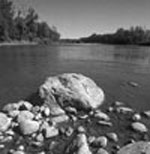Minnesota River Timeline
|
1650s European explorers encounter Objibwe and Dakota inhabitants. |
|
1700 First European American settlement. Pierre Charles Le Sueur and 27 men erect a wooden fort at the junction of the Blue Earth and Le Sueur Rivers. |
|
1800-52 French and English explorers and fur traders called the river St. Peters. |
|
1803 Louisiana Purchase - Minnesota River becomes part of the United States. |
|
1835 English geologist George Featherstonhaugh makes a canoe voyage and describes the river: "Transparent waters, riverbeds of white, sand, gracefully sloping banks and abundant wildlife." At Mankato, he writes: "The loveliest encampment I had yet met with; charming slopes, with pretty dells intersecting them." |
|
1836-37 John Charles Fremont surveys the tributaries of the Minnesota River. |
|
1838 Joseph Nicolas Nicollet takes canoe journey up the river and maps the river valley. |
|
1849 Minnesota Territory formed. |
|
1851 Treaty of Traverse des Sioux - Early European American Settlement. |
|
1852 Henry Jackson and P.K. Johnson select Mankato townsite at the junction of the Blue Earth and Minnesota Rivers. |
|
1858 Minnesota Statehood. |
| 1860s Steamer Jeannette Roberts makes trips from St. Paul to Mankato: 40-50 staterooms onboard. |
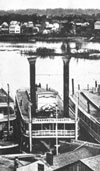 Click to enlarge |
|
1862 Tremendous flood - all bridges are destroyed and washed away. |
|
1870s Cummings Ferry docked at Sibley Park. Ten cents fare for team of horses and wagon. |
 Click to enlarge |
| 1879 First Iron Truss Bridge. |
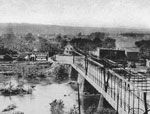 Click to enlarge |
| 1881 Largest flood on record. |
 Click to enlarge |
| 1887 Sibley Park created (junction of Blue Earth and Minnesota Rivers). |
 Click to enlarge |
| 1897 Last Paddle Wheeler - Henrietta. |
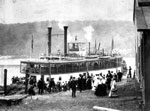 Click to enlarge |
|
1899 First US pollution-control law, the Rivers and Harbors Act, forbids liquid-waste dumping, other than from sewers into navigable waters. |
| 1908 Flood (Range St.) |
 Click to enlarge |
| 1910 Rapidan Dam (Blue Earth River). |
 Click to enlarge |
| 1911 Red Jacket Bridge (Le Sueur River). |
 Click to enlarge |
|
1912-23 Clamming industry booms. Shells used for cement and buttons. |
|
1917 New Concrete Bridge. |
|
1930s Damaging practices in the use of land and water are recognized as impacting water quality. |
|
1933 The US Civilian Conservation Corps workers plant trees, build dams, and pursue other environmental projects. |
|
Late 1930s In drought years, the river bottom was farmed. |
|
1945 Minnesota's Water Pollution Control Commission is established. |
|
1948 Federal Water Pollution Control Act. |
|
1950s Corps of Engineers straightened the river near Mankato (cut off meander through Hiniker Pond). |
|
1950s Post WWII growth increases demand for food. Massive agricultural drainage projects utilize more cropland and commercial fertilizers and pesticides to boost yields. |
| 1951 & 1961 Major Spring Floods. More on floods. |
 Click to enlarge |
|
1959 Notable low flow year. |
|
1962 Rachel Carson writes "Silent Spring" about environmental damage caused by pesticides. |
|
1965 Flood - Major Spring Floods. More on floods. |
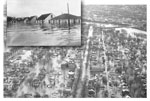 Click to enlarge |
|
1967 Minnesota Pollution Control Agency replaces the Water Pollution Control Commission. |
|
1970 First Earth Day. |
|
1970 Mankato/North Mankato floodwall construction begins. Completed in 1989. |
|
1972 Federal Clean Water Act. |
|
1974 Federal Safe Drinking Water Act. |
|
1975 First Minnesota River Fish Consumption Advisory due to elevated PCBs. |
|
1976 Notable low flow year - the river was a series of separate pools connected by a small stream. |
|
1977 Minnesota Basin Report identifies problems with elevated sediment and nutrient levels and reductions in wetlands. |
|
1983 Conservation Foundation ranks Minnesota first among the 50 states in efforts to protect the environment. |
|
1985 Conservation Reserve Program established to create buffer areas of natural vegetation along rivers and streams to prevent erosion. |
| 1985 Veterans Memorial Bridge built. |
 Click to enlarge |
|
1985 River's low dissolved oxygen problem identified as a problem. |
|
1987 Water Resources Center formed at Minnesota State University, Mankato. |
|
1992 Governor Arne Carlson launches clean up program for the river which he says "needs tremendous improvement." He issued a challenge to make the river fishable and swimmable by 2002. |
|
1993 Minnesota River highest level in recorded history at Mankato. |
|
1994 Citizen Action Committee (CAC) issues plan to restore the Minnesota River. |
|
1994 Minnesota River Assessment Project (MRAP) examines the effect of pollution on the river's physical, chemical, and biological systems. |
|
1995 Minnesota River Basin Joint Powers Board formed (now called the Minnesota River Board). |
|
1997 Major flood. |
|
1997 American Rivers lists the Minnesota as one of 10 most threatened rivers in the US. |
|
1998 Conservation Reserve Enhancement Program (CREP) created to protect and enhance environmentally sensitive land in the Minnesota River Basin through volunteer enrollment in conservation easements. |
|
2000 City of Mankato constructs a $25 million wastewater treatment plant expansion to reduce impacts on the river. |
|
Photos courtesy of Blue Earth County Historical Society & the Minnesota Historical Society |


